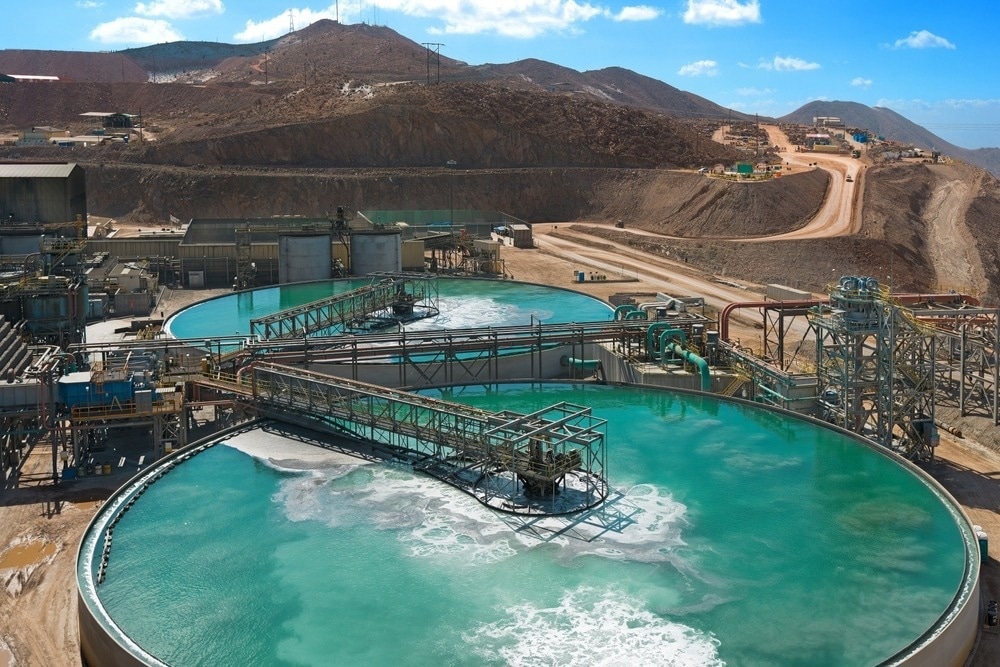Water is used extensively in mining operations for extraction, slurry storage and transport, dust suppression, and mineral processing. This article discusses using the latest technologies to manage water consumption in mining operations.

Image Credit: Jose Luis Stephens/Shutterstock.com
Importance of Managing Water Consumption in Mining
Lakes, streams, rivers, and groundwater act as the primary sources of water required for mining operations. Water is obtained from commercial water service suppliers in several mining sites that lack natural freshwater sources.
Mining activities will witness significant growth in the upcoming years due to the increasing demand for minerals in different applications, which can substantially increase water consumption in mining. For instance, the demand for cobalt, graphite, and lithium will increase substantially for renewable energy generation and storage.
However, the extraction of water from different sources for mining activities has polluted local rivers, reduced groundwater levels, and depleted surface water, leading to acute freshwater scarcity in several regions.
Moreover, achieving water sustainability has also become critical for mining industry players due to the adverse effects of water scarcity and pollution on their operations in recent years.
Mining and engineering companies, wastewater and water utilities, and government agencies are using the latest technologies to reduce water consumption, optimize water supply, and recycle water required for mining operations.
Latest Technologies for Water Management in Mining
Seawater desalination technologies have received significant attention for reducing freshwater consumption in mining operations. For instance, mining companies have focused on developing northern Chile's seawater desalination and transportation infrastructure to obtain water for lithium and copper mining.
Several new technologies have been developed to reduce water usage. For instance, magnetic resonance (MR) analysis is performed at the mining site to determine the high-grade ore portions.
Real-time analysis is performed by measuring the radio impulse resonance from ore batches, and low-grade ore portions are discarded immediately and transported to the dump. Therefore, the technology can significantly decrease water consumption by reducing mineral processing volumes.
Similarly, coarser particle filtration can remove unnecessary materials from the ore. In this method, the ore is crushed into powder, fed into flotation units filled with water, and foaming agents are added.
Necessary mineral particles separated through this method are transferred for further processing while unnecessary materials/wet tailings are removed. The coarser particle recovery process leads to significant water savings and improvements in energy efficiency.
The use of dry disposal and coarser particle filtration methods can reduce water consumption by 50%. Traditional tailings dams consist of waste with high water content. Latest dry disposal technologies allow pressing and filtering waste to remove water, which is then recycled.
Smart mining
Modern technologies such as analytics-backed Internet of Things (IoT) sensors and artificial intelligence (AI) can maximize wastewater reuse and reduce energy consumption in mining operations' wastewater/water treatment processes.
AI systems can be installed at mining sites to leverage historical data and constantly optimize and monitor assets for water consumption. Real-time data monitoring/automated measurement systems such as wireless sensor networks (WSNs), data lake/data warehouse, and enhanced machine learning can significantly optimize water management and increase the productivity of mines.
For instance, WSNs collect flow data and physicochemical parameters to treat and manage mine water. Artificial neural networks (ANNs) are the primary tool in machine learning used to predict the mine water quality.
These networks are computational models consisting of processing elements that receive input data and produce a single output instantaneously. ANNs have been used to model and predict the residual aluminum concentrations in the surface waters of southern Australia.
Recently, a mine water management system integrating Industry 4.0 has been proposed that uses disruptive technologies to treat and manage mine water. In this system, nano-electric sensors are installed extensively in the mine to monitor data in real-time and quantum computing is used to achieve faster processing of data administered in the blockchain.
All mine water treatment parameters can be collected using this system to develop a smart mine water treatment plant. The proposed system will ensure accurate data collection and monitoring, which can improve decision-making.
For instance, accurate water balance in mines can be maintained, and the risk of overflow can be reduced through early detection of mine water volumes by monitoring the inflows and outflows, leading to optimized water usage.
Conclusion and Future Outlooks of Water Consumption in Mining
The application of the latest technologies for managing water consumption in mining operations will expand in the upcoming years due to the growing focus on sustainable water use by decreasing water consumption and safely reusing the wastewater generated by mines after treatment.
Integrated control of all water-related processes in the mine will be crucial to optimize mine water treatment and management in future mining operations. However, substantial investments of money and time, cooperation among organizations and people at the mining sites, and careful planning considering all long-term and interconnected consequences are necessary to achieve this goal.
References and Further Reading
More, K. S., Wolkersdorfer, C., Kang, N., Elmaghraby, A. S. (2020). Automated measurement systems in mine water management and mine workings – A review of potential methods. Water Resources and Industry, 24, 100136. https://doi.org/10.1016/j.wri.2020.100136
More, K., Wolkersdorfer, C. (2019). Disruptive Technologies in Mine Water Management -The Future. https://www.researchgate.net/publication/343994373_Disruptive_Technologies_in_Mine_Water_Management_-The_Future
Botov, I., Budinich, G. R., Stella, C. (2023) Water Supply for Mining Industry: The Chile Case [Online] Available at https://www.adlittle.com/en/insights/viewpoints/water-supply-mining-industry-chile-case (Accessed on 08 May 2023)
Disclaimer: The views expressed here are those of the author expressed in their private capacity and do not necessarily represent the views of AZoM.com Limited T/A AZoNetwork the owner and operator of this website. This disclaimer forms part of the Terms and conditions of use of this website.